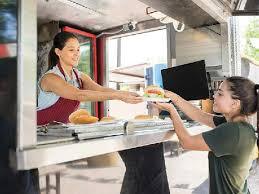Chefs and their Food Trucks; Then and now
Originally, food trucks seemed to emerge on the scene as a way for chefs without heavy financial backing to open a small, inexpensive, mobile restaurant. Seemingly, food trucks undermined the traditional brick-and-mortar approach to launching a restaurant business, which included long-term leases, heavy funding and personal guarantees, allowing chefs and owners to focus on the food and food trend.
On a global scale, the food truck industry has experienced substantial growth with the current day use of food truck finding apps and social media. Representing a $1.4B market in the U.S. in 2022, the growth rate of the food truck industry is only expected to rise in the coming years.
In the late 2000s, food trucks were popping up everywhere, but many city codes were not equipped to regulate them. Few rules were in place for mobile trucks that could park in a parking space, do their business, then leave when the sales volume died down.
A huge problem was Improper power or mobile kitchen configuration that increased the risk of food-borne illness (refrigeration, food prep surfaces, cross contamination, hot and cold holding); and vehicles may not even be safe to operate on the roads. Like restrictions for RVs and their passengers, food truck employees might or might not be properly seated and belted, leaving them exposed in an accident. Or hot grease sloshing around a fryer (that was meant for a stationary restaurant and not a mobile kitchen) could be very dangerous.
Some chefs thought their food truck would be a ticket to entrepreneurship from a W-2 job, but low margins and add on expenses meant they had to work on the truck every hour it operated. Trucks need a place to dump gray water and pick up propane and potable water. Additionally, the “sell till it’s gone” philosophy means that you want to store enough food to satisfy demand, but you can’t store so much that you carry food over to the next day. Often with food trucks, the leftover food cannot carry to the next day, so the truck must exhaust an area’s sales and then move on to move the rest of the product. This made labor tough to control. Owners who tried to legislate hours had higher food waste. Owners who said, “don’t come back until you sell out” ended up with higher labor costs.
Parked trucks did however, serve as a billboard for the brand. Trucks develop a reputation around a city to legitimize their brand. To solve the labor vs. food cost issue, you could turn each truck into an entrepreneurial effort for the truck crews. Truck crews can create their own LLCs and rent the trucks from the owner. They could requisition food from the restaurant and pay for it at cost plus a fair profit margin for the restaurant. Truck operators are then motivated to sell every bit of food to maximize their profits. You could create rules similar to a franchise, for uniforms, customer service, operator behavior, parking territories, and food quality. This could prove that a thoughtful restaurant and commissary structure might be the way to go.
Today, it’s all about predictability. Instead of returning to a “normal” parking space only to find another food truck has gotten their first or spending hours driving around looking for a place to set up. Food trucks are now banding together to form food truck parks with water, parking, picnic areas and often bands. Costs are pooled or managed by a third-party property owner to lease space. This way food truck operators are getting customers to come to them. They’re also getting on “circuits” or scheduled visits to set up in corporate lots or city centers. Like in any business, the better the chef/owner can predict demand and sales volume, the better they’ll be able to manage it and grow.
It’s just so fascinating to see such an interest in food trucks as a means to inject food and beverage into brick-and-mortar operations. Food trucks allow property owners to inject variety while eliminating complexity. We do see the current trend being that the property owner wants a piece of the profit…and with many food trucks operating at low volume, the food truck owners still find it more advantageous to stick to food truck parks and special events rather than share what little profit they make with a hotel or theme park. We’re waiting interestedly while this industry trend grows a flourishes.
Do you need assistance with advice on opening a food truck business? We’re here to help! Contact us today, and let’s chat. Wright Food Training administers educational food safety training. Services via classroom and on-line instruction for those in the restaurant, hospitality, school, medical/hospital, childcare and numerous additional food service industries. ServSafe Food Manager Certification/Certified Food Protection Manager Certification earned through Wright Food Training is good in all 50 states for 5 years.


